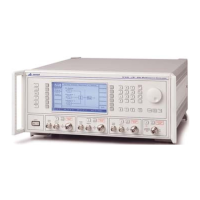INSTALLATION
2-10 46882/439
case metalwork, no attempt should be made to perform the tests on functional earths (e.g. signal
carrying connector shells or screen connections) as this will result in damage to the equipment.
3. Insulation tests
A 500 V DC test should be applied between the protective earth connection and combined live and
neutral supply connections with the equipment supply switch in the ‘on’ position. It is advisable
to make the live/neutral link on the appliance tester or its connector to avoid the possibility of
returning the equipment to the user with the live and neutral poles linked with an ad-hoc strap.
The test voltage should be applied for 5 seconds before taking the measurement.
IFR Ltd employs reinforced insulation in the construction of its products and hence a minimum
pass limit of 7 MΩ should be achieved during this test.
Where a DC power adapter is provided with the equipment, the adapter must pass the 7 MΩ test
limit.
We do not recommend dielectric flash testing during routine safety tests. Most portable appliance
testers use AC for the dielectric strength test which can cause damage to the supply input filter
capacitors.
4. Rectification
It is recommended that the results of the above tests are recorded and checked during each repeat
test. Significant differences between the previous readings and measured values should be
investigated.
If any failure is detected during the above visual inspection or tests, the equipment should be
disabled and the fault should be rectified by an experienced Service Engineer who is familiar with
the hazards involved in carrying out such repairs.
Safety critical components should only be replaced with equivalent parts, using techniques and
procedures recommended by IFR Ltd.
The above information is provided for guidance only. IFR Ltd designs and constructs its products
in accordance with International Safety Standards such that in normal use they represent no hazard
to the operator. IFR Ltd reserves the right to amend the above information in the course of its
continuing commitment to product safety.
Cleaning
Before commencing any cleaning, switch off the instrument and disconnect it from the supply.
The exterior surface of the case may be cleaned using a soft cloth moistened in water. Do not use
aerosol or liquid solvent cleaners.
Cleaning the LCD window
To prevent damage to the LCD window, care should be taken not to scratch the surface during use
and also when cleaning. The LCD window should be cleaned by wiping a slightly damp, soft,
lint-free cloth gently over the surface.
Putting into storage
If the instrument is to be put into storage, ensure that the following conditions are maintained:
Temperature range:
−40 to 70°C
Humidity: Less than 93% at 40°C

